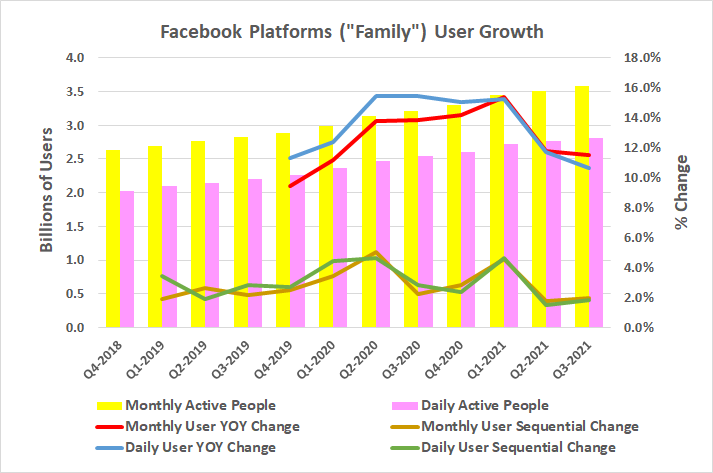By most measures, it was a healthy enough quarter. Facebook (FB +0.61%) was more profitable than analysts had expected, and while the company's third-quarter top line fell short of estimates, both metrics were firmly higher on a year-over-year basis. And the company continued to bring active users of its social media platforms into the fold. The knee-jerk selling of the stock stemming from lackluster fourth-quarter guidance was and still is relatively well-contained.
Investors willing and able to look past all the recent drama surrounding the social networking giant, however, may have noticed something within Facebook's quarterly update that not enough people are talking about. That is, total user growth has decelerated to record-low, near-nil levels, while per-user revenue appears to have hit a wall.
Could Facebook be facing its "as good as it gets" milestone?
Maxed out
That's not merely a rhetorical question. Indeed, given a couple of the user metrics Facebook regularly supplies to shareholders as part of its quarterly update, it's a completely legitimate question well worth asking.

One of these metrics is the sheer number of people regularly using at least one of Facebook's digital venues -- Instagram, WhatsApp, and of course, Facebook itself -- on a monthly and daily basis. Both figures were up sequentially as well as on a year-over-year basis last quarter... again. Daily users edged up to 2.81 billion, while monthly users grew to 3.58 billion during the third quarter of this year. That forward progress also carried both metrics deeper into record-high territory.
Yet, that forward progress was also the second-weakest sequential (from the second quarter to Q3) daily user growth rate of 1.8% Facebook has seen since it's been collecting and publishing the information...with the weakest growth taking shape during Q2 of this year when it slumped to 1.5%. Sequential growth of monthly users is waning as well.

Data source: Facebook. Chart by author.
In other words, Facebook's ability to attract new users to its social networking sites is fading. Last year's COVID-driven user surge is not only not experiencing a great deal of follow-through, but the surge itself may also have pushed Facebook significantly closer to its maximum potential number of regular users. Moreover, while not shown on the image below, user headcounts in North America and Europe have been stagnant since early 2020. Other markets may not be far behind their similar headwinds.
This slowdown in and of itself isn't devastating. In fact, it could have been expected; there's a limit on the number of people in the world who can and will plug into at least one of Facebook's apps. Besides, headcounts are still growing.
When paired with the other metric in question, though, slowing user growth prompts bigger concerns.
That other metric is average revenue per user, or ARPU. Last quarter's ARPU of $8.18 is 21% higher than the year-earlier comp of $6.76. But, for the first time in recent history, third-quarter ARPU fell from the second quarter's average user revenue. That is to say, per-user revenue typically rises in Q3 versus Q2's figure. Not even Facebook's most valuable users -- from the aforementioned North American and European markets -- generated more revenue last quarter than they did during Q2. That's a big problem, as more than two-thirds of Facebook's business is done on those two continents.

It would be short-sighted to ignore the unusual circumstances of 2020 that are lingering in 2021. Namely, the pandemic prompted many advertisers to close their purse strings until there was greater clarity regarding the future. When that clarity finally took shape in the latter part of last year, advertising spending rematerialized, in spades. Advertisers are still searching for the optimal spending mix in this so-called "new normal" environment.
Facebook's ARPU headwind is noteworthy all the same, however, in that it could be a bigger-picture hint that Facebook itself is falling out of favor as a preferred advertising medium.
Don't panic, but do watch carefully
It's not necessarily a reason to dump any Facebook shares you may own... at least not yet. One unusual quarter doesn't make a trend, and even if this is evidence of a budding trend, Facebook is preparing for the future by rethinking everything it does and is. For instance, the social media platform is investing heavily to become what CEO Mark Zuckerberg describes as a "metaverse company" that serves as a digital host of sorts for virtual reality spaces where real people can connect with one another.
Facebook can monetize this effort by selling (or advertising) virtual goods or experiences. Such an initiative would also ramp up demand for the company's Oculus-branded VR hardware.
Given the sheer uncertainty about this new kind of social media, though -- in addition to Zuckerberg's acknowledgment that it could take years for a metaverse platform to become ready for commercialization -- last quarter's ARPU and user-growth red flags don't stop waving. Facebook mania may have fully run its course, ushering in a new and less impressive era of the company's existence. It's a concern simply because investors have never seen Facebook struggle to grow its top or bottom lines. Now they just might.
